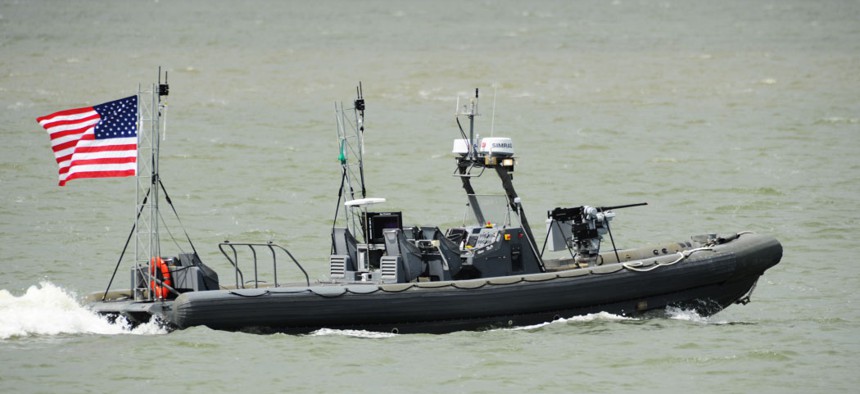
DOD office looks to field weapons faster
The Strategic Capabilities Office is working on rapid deployment of autonomous weapons and an "arsenal plane."
As the Pentagon prepares to unveil a tech-heavy budget request, senior officials are highlighting a low-profile office created in 2012 to identify new capabilities and rush them to the battlefield.
Defense Secretary Ashton Carter gave the Strategic Capabilities Office (SCO) a shout out during a budget preview before the Economics Club of Washington this week. Carter cited a growing list of SCO projects moving from the drawing board to the field, including "swarming autonomous vehicles" and a "flying launch pad."
According to DOD's fiscal 2013 budget request, the office was created to "identify, analyze, and accelerate capabilities to counter strategic adversaries and improve the United States posture for engaging future threats." Overseen by the Office of the Secretary of Defense, the Combatant Commands and U.S. intelligence agencies, the office "blends technology and concepts of operations to develop a full spectrum of innovative capabilities."
Carter formed the new office while he served as deputy defense secretary. He appointed William Roper, a DOD veteran and former member of the technical staff at MIT Lincoln Laboratory, to head SCO.
It's unclear how SCO differs from other Pentagon R&D agencies, particularly the Defense Advanced Research Projects Agency. The main difference appears to be a stronger emphasis on rapid development and fielding of new weapon capabilities.
In his budget preview, Carter said he created SCO "to help us to re-imagine existing DOD and intelligence community and commercial systems by giving them new roles and game-changing capabilities." The emphasis, he added, was "getting stuff in the field quickly."
The office is part of a huge Pentagon R&D investment expected to exceed $71 billion in 2017, a total "that no other institution in the United States or the world comes close to," Carter stressed.
The Pentagon chief then ticked off a list of SCO projects currently in the pipeline, including:
- An advanced navigation initiative that uses miniaturized cameras and sensors to augment the existing targeting system on the Air Force's Small Diameter Bomb. Carter said a modular kit could be fitted to other munitions "enabling off-network targeting through commercial components."
- "Swarming" autonomous vehicles, or micro-drones, capable of flying through heavy winds or being ejected from fighter aircraft flying just below the speed of sound.
- Autonomous boats that can be networked for a variety of missions like fleet defense and close-in surveillance, "without putting sailors at risk," Carter explained. The Office of Naval Research has developed a system for giving boats autonomy through its CARACaS program.
- Converting existing rail, or electromagnetic, gun technology along with hypervelocity projectiles developed for missile defense, then using the technology for point defense. Carter said the advanced munitions could be used on Navy destroyers or with Army Paladin howitzers. "We also found that [hypervelocity projectiles] significantly increases the Paladin's range," Carter said.
- An "arsenal plane" that would operate like a "flying launch pad" for delivering different conventional payloads. "The arsenal plane will function as a very large airborne magazine," Carter said, that would be "networked" with F-22 and future F-35 fighters serving as "forward sensor and targeting nodes."
Carter added that SCO projects seek to leverage commercial components, including some fabricated using 3D printing. The self-driving boats use artificial intelligence algorithms first developed for Mars landers, he noted.
In his speech, Carter also stressed that "we'll now have to deal with [enemies] across all domains, not just the usual air, land and sea, but also particularly in the areas of cyber, space and electronic warfare, where our reliance on technology has given us great strengths, but also lead to vulnerabilities that adversaries are eager to exploit."
At the same time, the air war against the Islamic State is depleting stockpiles of smart munitions. "We've recently been hitting ISIL with so many GPS-guided smart bombs and laser-guided rockets that we are starting to run low on the ones that we use against terrorists the most," Carter said. "So we're investing $1.8 billion in FY17, to buy over 45,000 more of them."